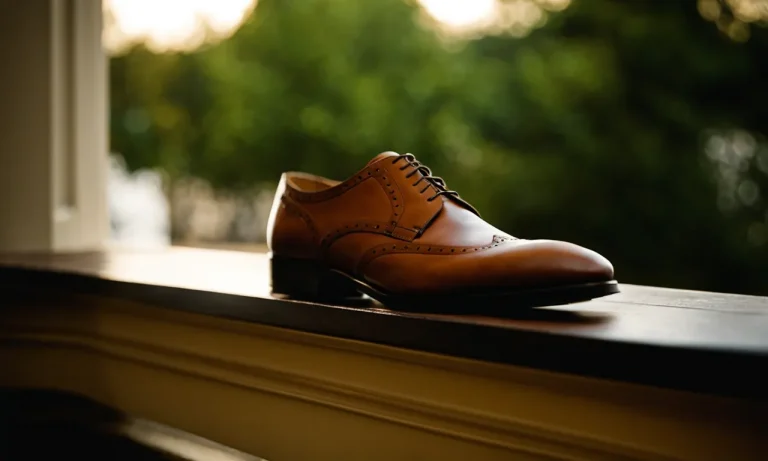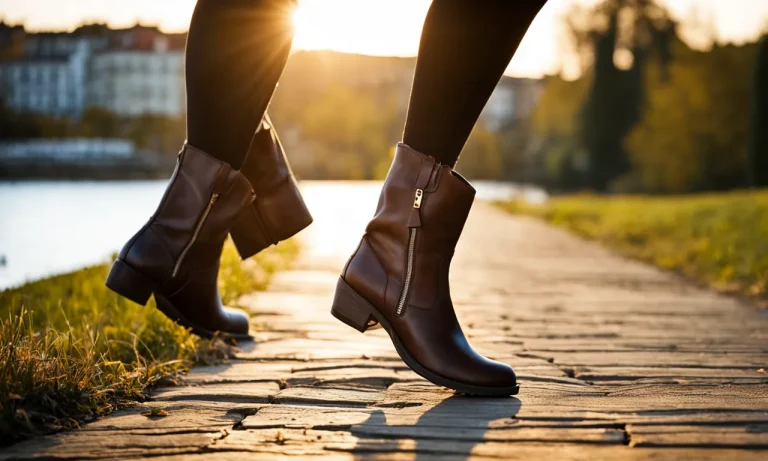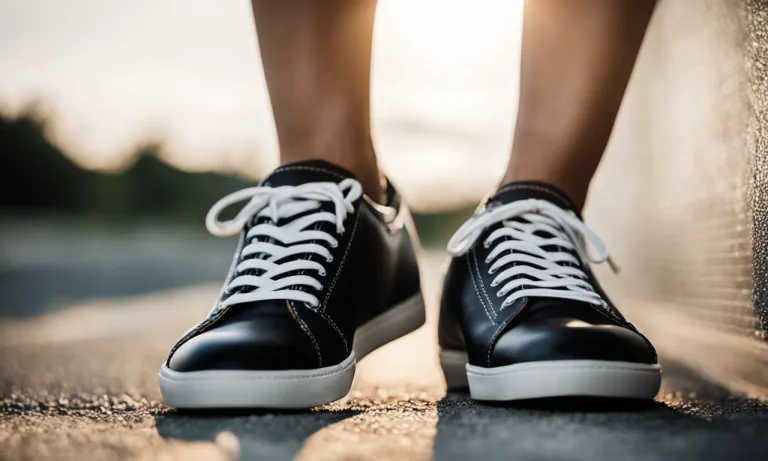Scuffs and scratches on leather boots are an inevitable part of wear and tear. But before you resign yourself to scuffed up boots, know that many scuffs can be fixed with a little TLC and elbow grease.
If you’re short on time, here’s a quick answer to your question: using a leather conditioner, gently buffing the scuffs with a soft cloth or brush, and applying a little shoe polish can help diminish scuffs and restore your boots’ luster.
In this comprehensive guide, we’ll go over everything you need to know about repairing minor scuffs and scratches on leather boots, from identifying the type of leather to DIY remedies you can use at home. Read on to restore your boots to their original glory!
Determine the Type of Leather
Before attempting to fix scuffs on your leather boots, it is important to determine the type of leather they are made of. Different types of leather require different cleaning and repair methods. Here are some common types of leather used in boots:
Smooth Leather
Smooth leather is the most common type of leather used in boots. It has a smooth and polished surface that is relatively easy to maintain. To determine if your boots are made of smooth leather, look for a uniform texture and shine.
To fix scuffs on smooth leather boots, you can use a leather cleaner and conditioner. Apply a small amount of cleaner to a soft cloth and gently rub it onto the scuffed area. Then, apply a conditioner to keep the leather moisturized and prevent further damage.
Suede Leather
Suede leather has a soft and velvety texture that gives boots a unique look. However, scuffs on suede leather can be more challenging to fix. To determine if your boots are made of suede leather, look for a fuzzy and napped surface.
If your suede leather boots have scuffs, you can try using a suede brush or eraser to gently buff the scuffed area. Be careful not to apply too much pressure, as it may damage the surface. If the scuff is stubborn, you can also try using a specialized suede cleaner.
Nubuck Leather
Nubuck leather is similar to suede leather, but it has a finer grain and a smoother surface. It is known for its durability and resistance to wear and tear. To determine if your boots are made of nubuck leather, look for a soft and velvety texture with a slight sheen.
To fix scuffs on nubuck leather boots, you can use a nubuck cleaner and conditioner. Apply the cleaner to a soft cloth and gently rub it onto the scuffed area. Then, use a nubuck conditioner to restore the leather’s natural oils and protect it from further damage.
Exotic Leather
Exotic leather, such as snakeskin or crocodile leather, requires special care due to its unique texture and pattern. To determine if your boots are made of exotic leather, look for distinct patterns or textures that are not commonly found in other types of leather.
When it comes to fixing scuffs on exotic leather boots, it is best to consult a professional leather cleaner or repair specialist. They have the expertise and knowledge to handle these delicate materials and ensure the best possible results.
Remember, regardless of the type of leather your boots are made of, it is always a good idea to test any cleaning or repair products on a small, inconspicuous area first to ensure compatibility and avoid any potential damage.
Clean and Condition the Leather
When it comes to fixing scuffs on leather boots, the first step is to clean and condition the leather. This is important because it helps to remove dirt, grime, and any built-up residue that may be contributing to the scuffs.
Additionally, conditioning the leather helps to restore its moisture and flexibility, making it less prone to future scuffing.
Use a Leather Cleaner
To clean your leather boots, start by using a leather cleaner. There are many great leather cleaners available on the market, so be sure to choose one that is safe and effective for use on leather. Follow the instructions on the cleaner’s packaging, but generally, you’ll want to apply the cleaner to a soft cloth and gently rub it into the scuffed areas.
This will help to lift away any dirt or grime that may be causing the scuffs.
Pro tip: If you don’t have a leather cleaner on hand, you can make your own by mixing equal parts water and vinegar. This homemade solution can be just as effective at cleaning leather boots.
Apply a Leather Conditioner
After cleaning your leather boots, it’s important to apply a leather conditioner. This step helps to moisturize the leather and restore its natural oils, which can be lost over time. Apply the conditioner to a soft cloth and gently rub it into the leather, focusing on the scuffed areas.
Allow the conditioner to soak in for a few minutes, and then wipe away any excess with a clean cloth.
Pro tip: Look for a leather conditioner that contains natural oils, such as lanolin or beeswax, as these ingredients can provide extra nourishment and protection for your leather boots.
Remember, regular cleaning and conditioning can help to prevent scuffs and keep your leather boots looking great for years to come. If you’re unsure about the specific products to use on your boots, consult the manufacturer’s recommendations or seek advice from a professional leather care specialist.
Gently Buff the Scuffs
When it comes to fixing scuffs on leather boots, one of the first steps is to gently buff the scuffs. This process helps to minimize the appearance of the scuffs and restore the boots’ original look. There are a few different methods you can try to effectively buff out the scuffs.
Use a Soft Cloth
One simple and effective way to buff scuffs on leather boots is to use a soft cloth. Start by dampening the cloth slightly, making sure it is not too wet. Then, apply a small amount of leather cleaner or conditioner to the cloth and gently rub it onto the scuffed area.
Use circular motions and apply light pressure to buff out the scuffs. Be sure to thoroughly clean and condition the entire boot to maintain its overall appearance.
Try a Suede Brush or Toothbrush
If you are dealing with scuffs on suede leather boots, a suede brush or toothbrush can be a great tool to have. Start by gently brushing the scuffed area in one direction to remove any dirt or debris. Then, use the brush to lightly buff the scuffs in circular motions.
This can help to restore the suede’s texture and minimize the appearance of the scuffs. Remember to brush the entire boot to ensure a consistent look.
Remember, it’s always a good idea to test any cleaning or conditioning products on a small, inconspicuous area of the boot before applying them to the scuffed areas. This will help you ensure that the products won’t cause any damage or discoloration to your boots.
For more in-depth information on how to fix scuffs on leather boots or to explore additional tips and tricks, you can visit ShoeShineKit.com. They provide comprehensive guides and resources to help you keep your leather boots looking great.
Use Shoe Polish or Colorant
When it comes to fixing scuffs on leather boots, one of the most effective solutions is to use shoe polish or colorant. These products can help restore the color and shine of your boots, making the scuffs less noticeable. However, it’s important to follow the right steps to achieve the best results.
Match the Polish to the Leather Color
Before applying any shoe polish or colorant, it’s crucial to choose a product that matches the color of your leather boots. Using the wrong color can result in an uneven or unnatural finish, making the scuffs even more noticeable.
Take the time to find the right shade that closely matches your boots to ensure a seamless repair.
Pro tip: If you’re unsure about the color match, consult the manufacturer’s website or visit a reputable shoe repair shop for guidance. They may be able to provide recommendations or even custom-mix a color for you.
Use Small Amounts and Build Up Slowly
When applying shoe polish or colorant to your leather boots, it’s best to start with a small amount and gradually build up the coverage. This allows you to achieve a more natural-looking repair and prevents the product from clumping or creating an uneven surface.
Pro tip: Use a soft cloth or a small brush to apply the shoe polish or colorant in gentle, circular motions. This helps distribute the product evenly and ensures that it penetrates the scuffed areas.
Remember, fixing scuffs on leather boots requires patience and attention to detail. By using the right shoe polish or colorant and following the proper application techniques, you can successfully restore the appearance of your beloved boots and prolong their lifespan.
Consider Advanced Repair Techniques
Leather Filler Products
For deep scuffs that have removed layers of leather, using a leather filler product can help rebuild the damaged area (Leather filler can be a great option for more serious damage). These products are thick pastes that are specifically designed to bind to leather and fill in gouges and scratches.
Once applied and dried, the filler can be sanded smooth and painted or dyed to match the surrounding leather.
Some of the most popular leather filler products include:
- Famowood Glaze Coat – An affordable and easy to use leather filler compound.
- Pecard Leather Filler – Specially formulated for use on leather boots and shoes.
- Sof Sole Leather Patch – Comes with everything needed to fill and blend repairs.
When using a leather filler product:
- Make sure the area is clean before applying.
- Apply in thin layers, drying completely between coats.
- Sand until perfectly smooth once dried.
- Dye or paint to match surrounding leather.
Professional Repair Services
For the best results repairing badly damaged leather boots, consider taking them to a professional cobbler or leather repair specialist. These experts have the skills, tools and materials to make leather repairs that are nearly invisible.
Some repair services a cobbler can provide include:
- Filling deep gouges and scratches
- Repairing tears or punctures
- Restitching separated seams
- Replacing damaged heels or soles
- Dyeing to match leather color
- Polishing and conditioning
When looking for a leather repair shop, read online reviews and ask to see examples of their work. A skilled cobbler can often restore badly damaged leather boots to like-new condition. While professional repairs may be more expensive than DIY options, the quality of work will be unmatched.
Conclusion
With a bit of patience and the right techniques, you can significantly improve the appearance of scuffs and scratches on leather boots. While deep gouges may require professional help, most minor scuffs can be diminished or removed entirely with leather conditioner, targeted buffing, and shoe polish or colorant.
With proper care, your leather boots will last for years to come and maintain their good looks in the process.
Treating scuffs promptly and using the gentlest approach possible will get you the best results. Remember to properly clean and moisturize the leather before attempting any repairs. With a little know-how, you can keep your favorite leather boots looking great season after season.






